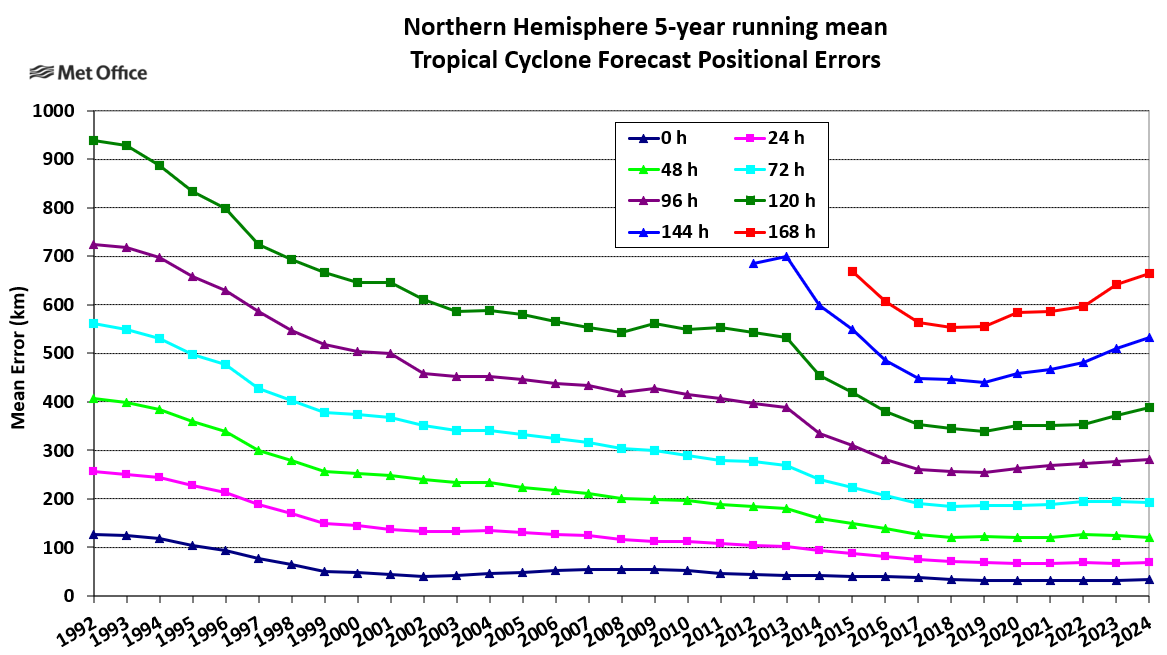Tropical cyclone verification northern hemisphere 2023
A summary of tropical cyclone activity in the Northern Hemisphere for the 2023 season together with an assessment of the performance of the Met Office global model in predicting the track and intensity of these tropical cyclones.
1. Introduction
A summary of tropical cyclone activity in the Northern Hemisphere for the 2023 season is presented below together with an assessment of the performance of the Met Office global model in predicting the track and intensity of these tropical cyclones.
Tropical cyclones are experienced in the North Pacific, North Atlantic and North Indian Oceans and nearby tropical seas with occasional tropical or subtropical storms in the Mediterranean Sea. For the purpose of tropical cyclone verification the northern hemisphere is divided in to five basins; the North-West Pacific (west of 180° E to the Malay Peninsula), the North-East Pacific (east of 180° E), the North Atlantic, the North Indian Ocean (west of the Malay Peninsula) and the Mediterranean Sea. Mean error statistics for the four main basins are presented together with a table of statistics for the whole Northern Hemisphere. Verification is performed at 12-hour intervals up to forecast time T+168, although statistics are only presented at 24-hour intervals in this report. The global model resolution in operation was 0.140625° x 0.09375° x 70 levels. This is equivalent to a horizontal resolution of 16 km × 10 km at the equator.
Tropical cyclone forecast verification - measures of error
Advisory positions received in real time from RSMC Tokyo, JTWC Hawaii, NHC Miami and CPHC Honolulu are used as verifying observations of storm location. Best track data from these centres will be obtained once they become available. Past experience shows that use of best track rather than real time data usually only makes minor differences to seasonal error statistics. Some mean error statistics for last season are also included for the purposes of a comparison. Forecast tracks are only verified when a depression reaches tropical storm status.
2. Tropical cyclone activity
| NWP | NEP | NAT | NI | MED | TOTAL | |
|---|---|---|---|---|---|---|
| Tropical depressions (<34 knots) | 2 (5) | 3 (0) | 1 (2) | 0 (0) | 0 (0) | 6 (7) |
| Tropical storms (34-63 knots) | 5 (13) | 7 (8) | 13 (5) | 4 (6) | 1 (1) | 30 (33) |
| Hurricanes/typhoons (>63 knots) | 11 (12) | 10 (10) | 7 (8) | 4 (1) | 0 (0) | 32 (31) |
| Total | 18 (30) | 20 (18) | 21 (15) | 8 (7) | 1 (1) | 68 (71) |
Categories assigned based on 1-minute averaged winds
Basin name abbreviations:
NWP : North-west Pacific (west of 180° E)
NEP : North-east Pacific (east of 180° E)
NAT : North Atlantic
NI : North Indian (west of Malay Peninsula)
MED : Mediterranean Sea
The number in brackets indicates the figure for the 2022 season.
3. Summary of northern hemisphere storms
3.1 North-west Pacific basin storms
| T+0 | T+24 | T+48 | T+72 | T+96 | T+120 | T+144 | T+168 | |
| Possibly verified | 206 | 174 | 144 | 119 | 98 | 79 | 61 | 43 |
| Detection rate (%) | 100 | 98 | 100 | 99 | 99 | 97 | 89 | 81 |
| AT error (km) | 0 | 1 | 8 | 6 | -39 | -99 | -253 | -302 |
| CT error (km) | -4 | 1 | 12 | 23 | 47 | 72 | 14 | 62 |
| Track skill (%) | ***** | 65 | 71 | 70 | ***** | ***** | ***** | ***** |
| * 2018-22 skill (%) | ***** | 62 | 69 | 70 | ***** | ***** | ***** | ***** |
| DPE (km) | 34 | 57 | 103 | 171 | 267 | 401 | 542 | 682 |
| * 2018-22 DPE (km) | 33 | 71 | 130 | 202 | 290 | 389 | 548 | 707 |
| Central pressure bias (mb) | 1.7 | 9.1 | 15.0 | 18.9 | 21.2 | 21.6 | 21.1 | 16.5 |
* 5-year running mean DPE and skill for all north-west Pacific storms 2018-22
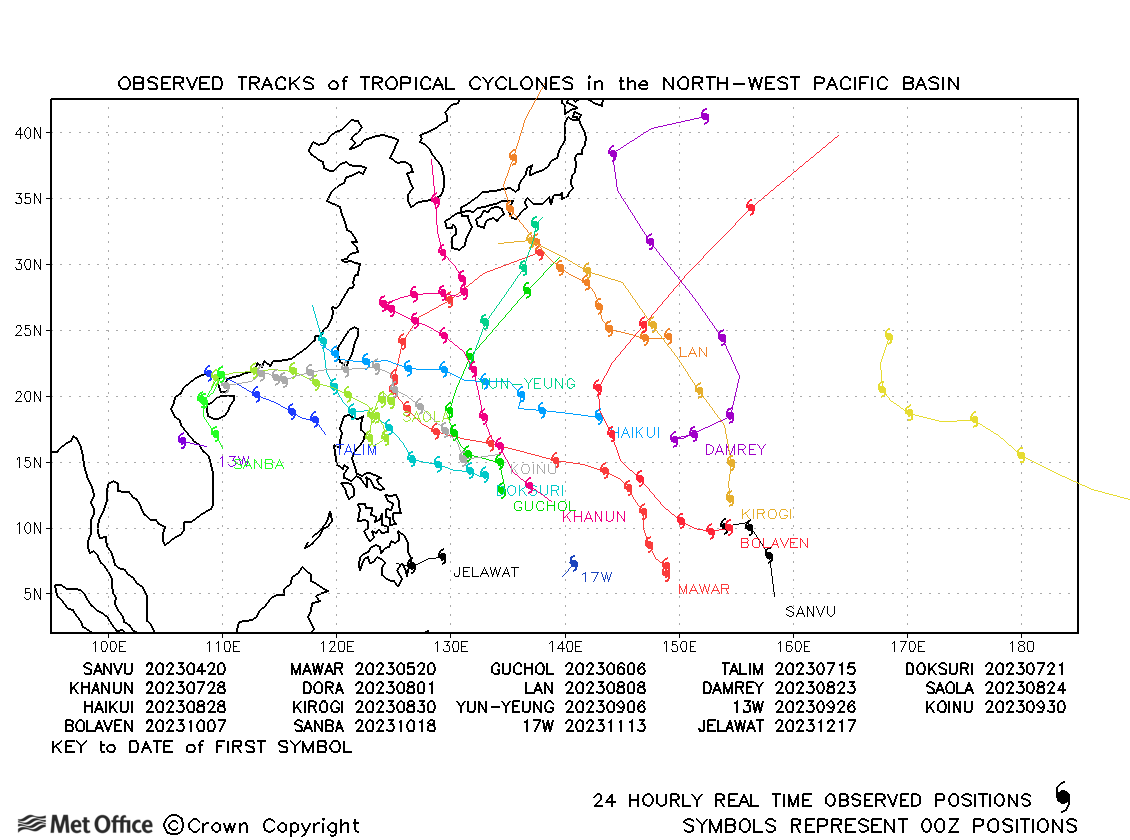
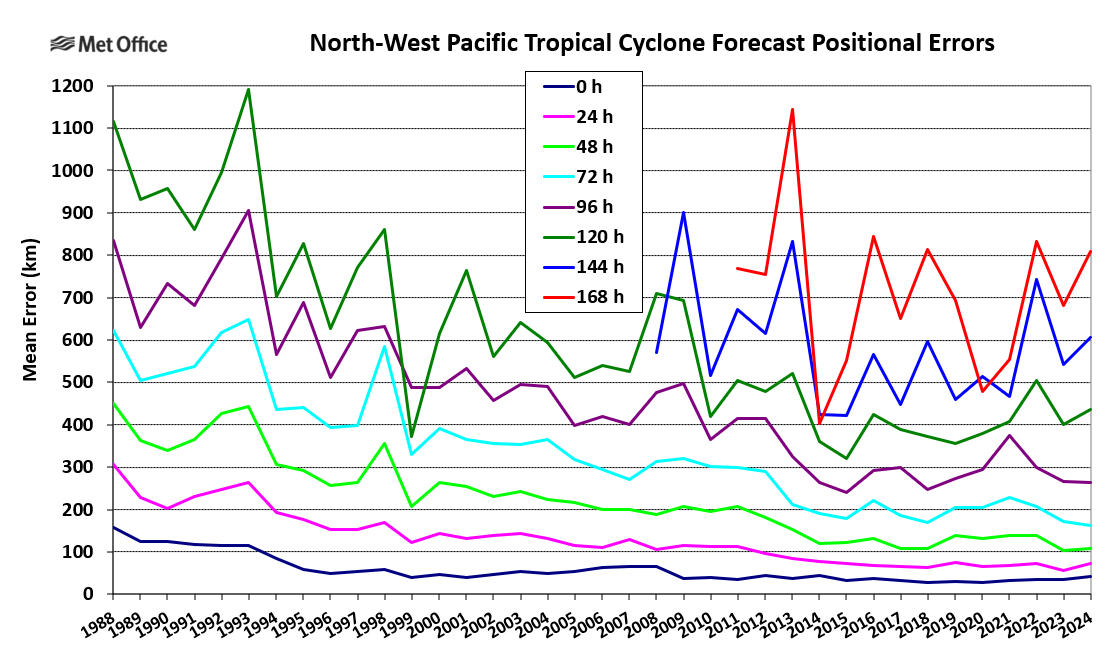
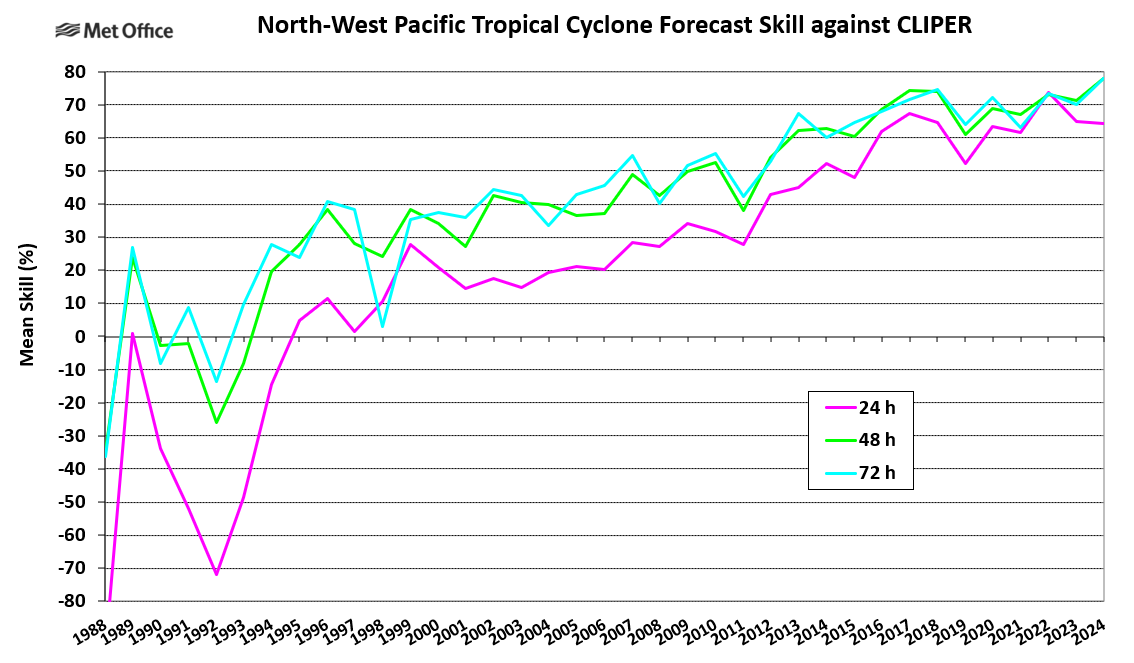
Total storm activity was much lower than 2022, although a high proportion reached typhoon status. Track forecast errors were close to or below the 5-year running mean. The central pressure bias became large at longer forecast lead times indicating forecast intensities were too weak.
3.2 North-east Pacific basin storms
| T+0 | T+24 | T+48 | T+72 | T+96 | T+120 | T+144 | T+168 | |
| Possibly verified | 158 | 124 | 93 | 69 | 50 | 34 | 24 | 16 |
| Detection rate (%) | 100 | 99 | 100 | 100 | 98 | 91 | 71 | 56 |
| AT error (km) | 1 | 11 | 17 | 13 | -17 | -17 | -156 | -148 |
| CT error (km) | -4 | -6 | -27 | -67 | -75 | -40 | 12 | -85 |
| Track skill (%) | ***** | 57 | 72 | 78 | ***** | ***** | ***** | ***** |
| * 2018-22 skill (%) | ***** | 54 | 64 | 68 | ***** | ***** | ***** | ***** |
| DPE (km) | 37 | 78 | 135 | 211 | 316 | 391 | 461 | 589 |
| * 2018-22 DPE (km) | 34 | 69 | 120 | 177 | 235 | 302 | 387 | 436 |
| Central pressure bias (mb) | 1.8 | 10.0 | 14.9 | 15.5 | 18.4 | 23.0 | 27.9 | 29.2 |
* 5-year running mean DPE and skill for all north-east Pacific storms for 2018-22
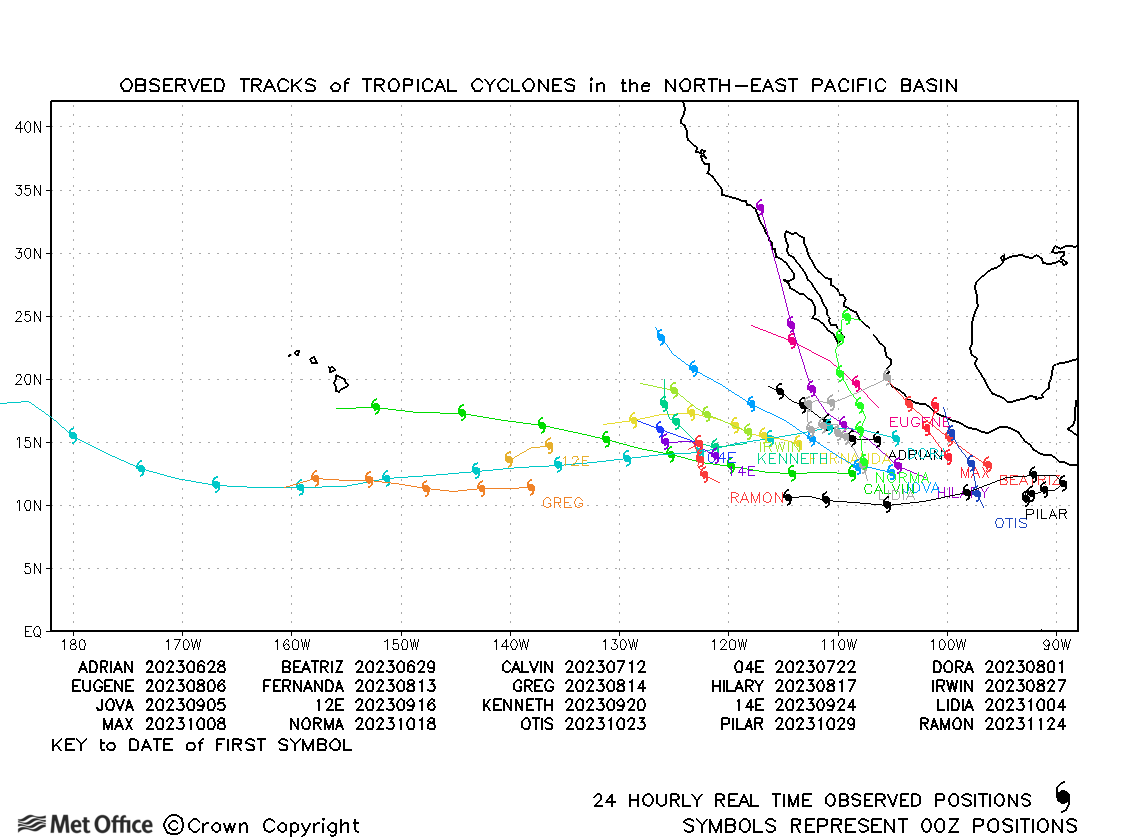
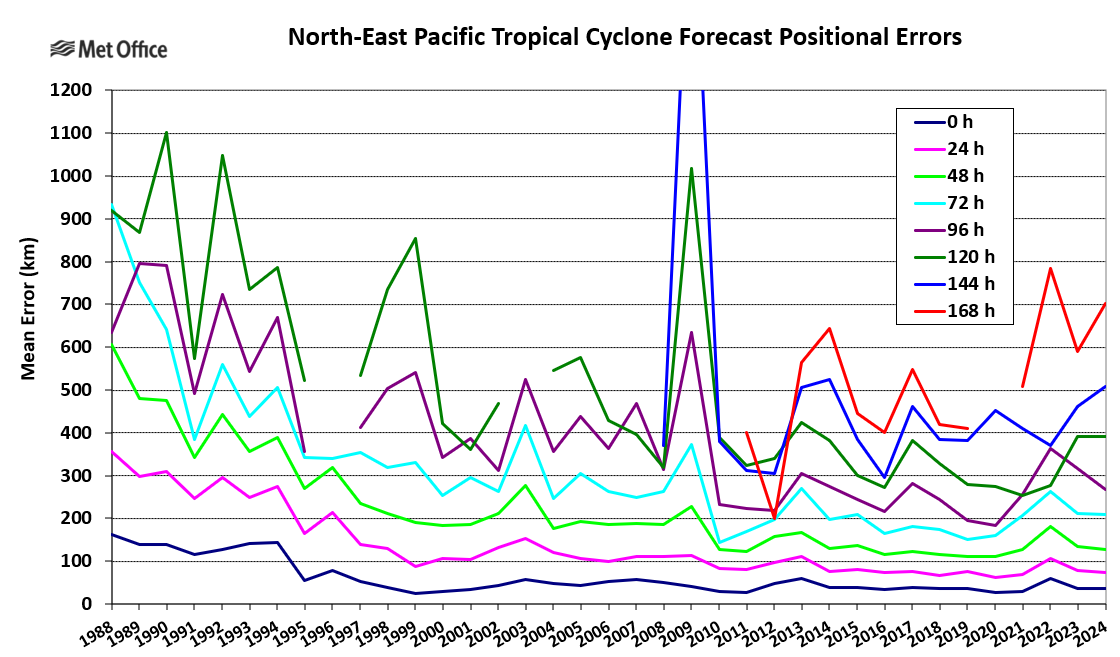
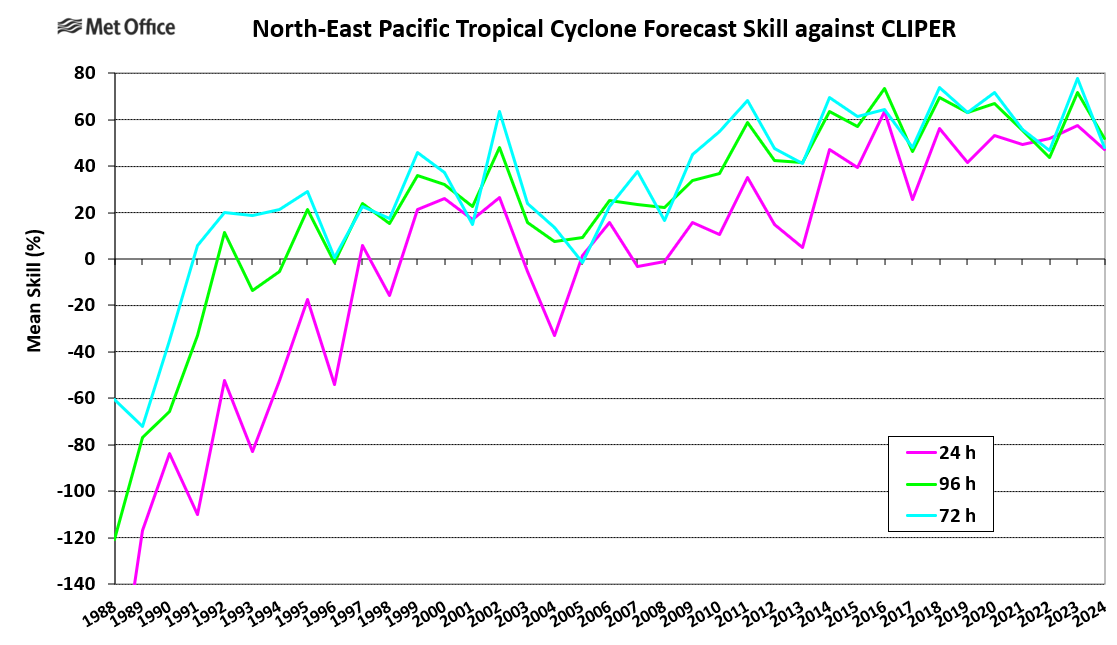
Activity was similar to 2022. Track forecast errors were higher than the 5-year running mean. A weak bias in central pressure forecasts increased with forecast lead time.
3.3 North Atlantic basin storms
| T+0 | T+24 | T+48 | T+72 | T+96 | T+120 | T+144 | T+168 | |
| Possibly verified | 205 | 164 | 132 | 108 | 87 | 73 | 59 | 45 |
| Detection rate (%) | 99 | 95 | 94 | 92 | 87 | 86 | 83 | 82 |
| AT error (km) | 4 | -3 | -19 | -24 | -34 | -15 | 13 | 73 |
| CT error (km) | -2 | -1 | 8 | 36 | 52 | 34 | 43 | 35 |
| Track skill (%) | ***** | 61 | 70 | 66 | ***** | ***** | ***** | ***** |
| * 2018-22 skill (%) | ***** | 70 | 74 | 73 | ***** | ***** | ***** | ***** |
| DPE (km) | 33 | 74 | 128 | 226 | 306 | 459 | 623 | 686 |
| * 2018-22 DPE (km) | 29 | 63 | 118 | 193 | 271 | 351 | 487 | 621 |
| Central pressure bias (mb) | 4.5 | 7.9 | 10.7 | 12.1 | 13.8 | 14.5 | 14.8 | 14.0 |
* 5-year running mean DPE and skill for all North Atlantic storms for 2018-22
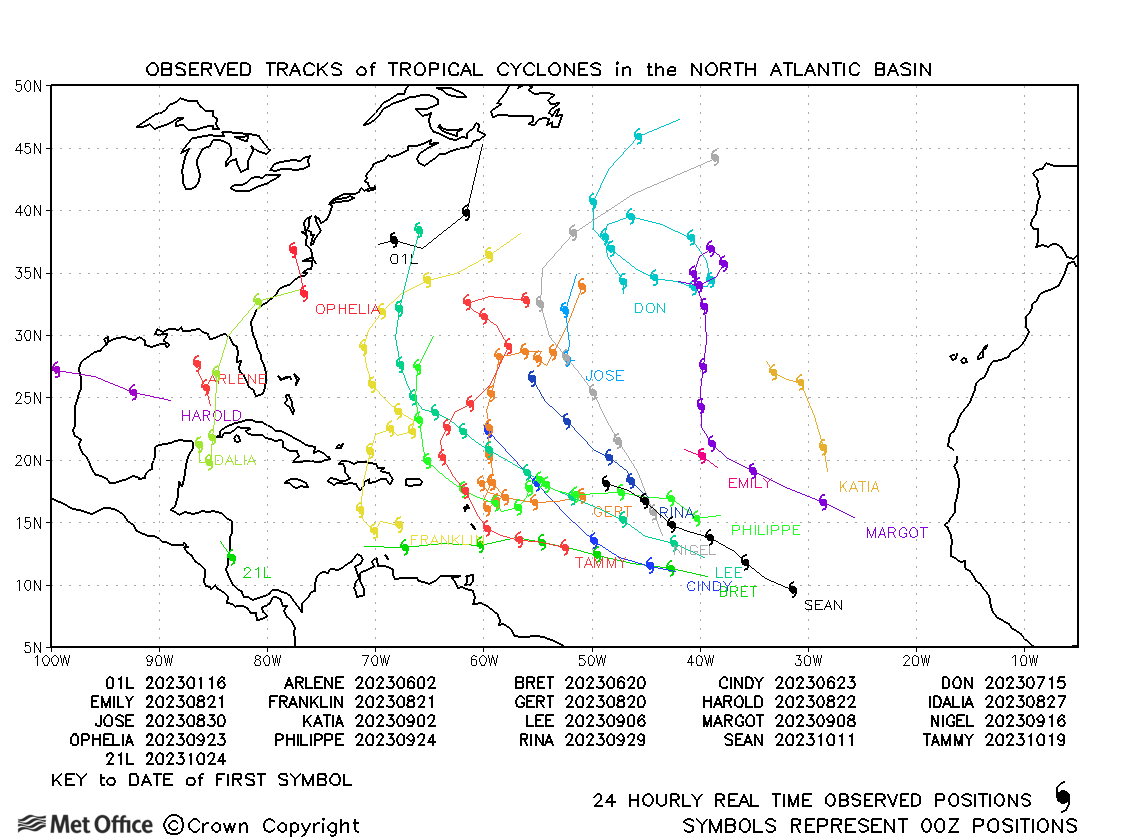
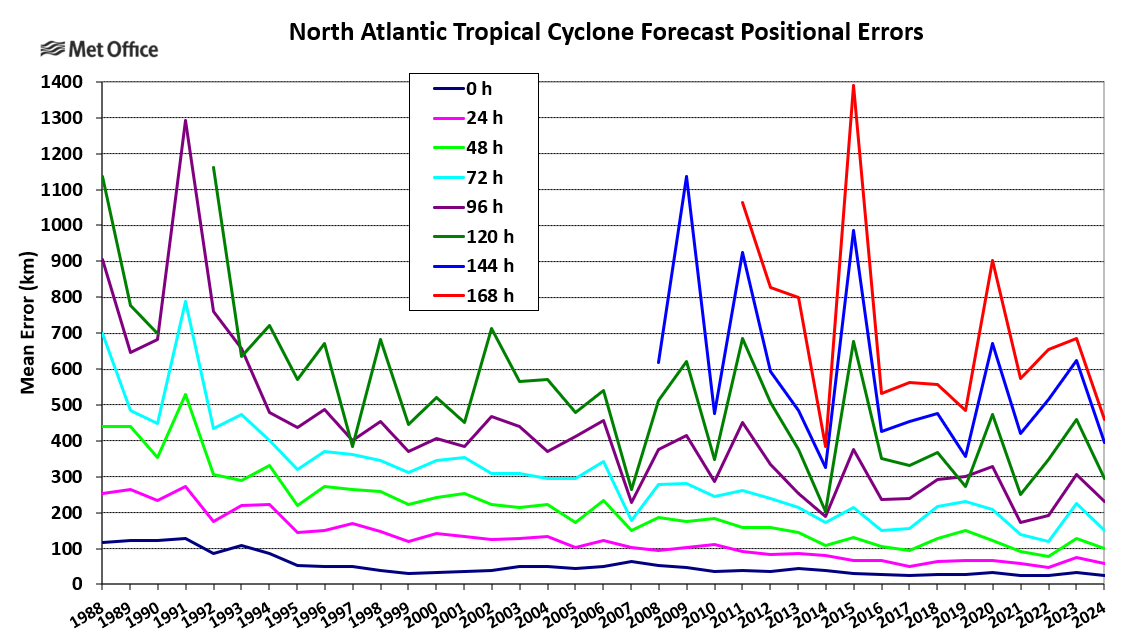
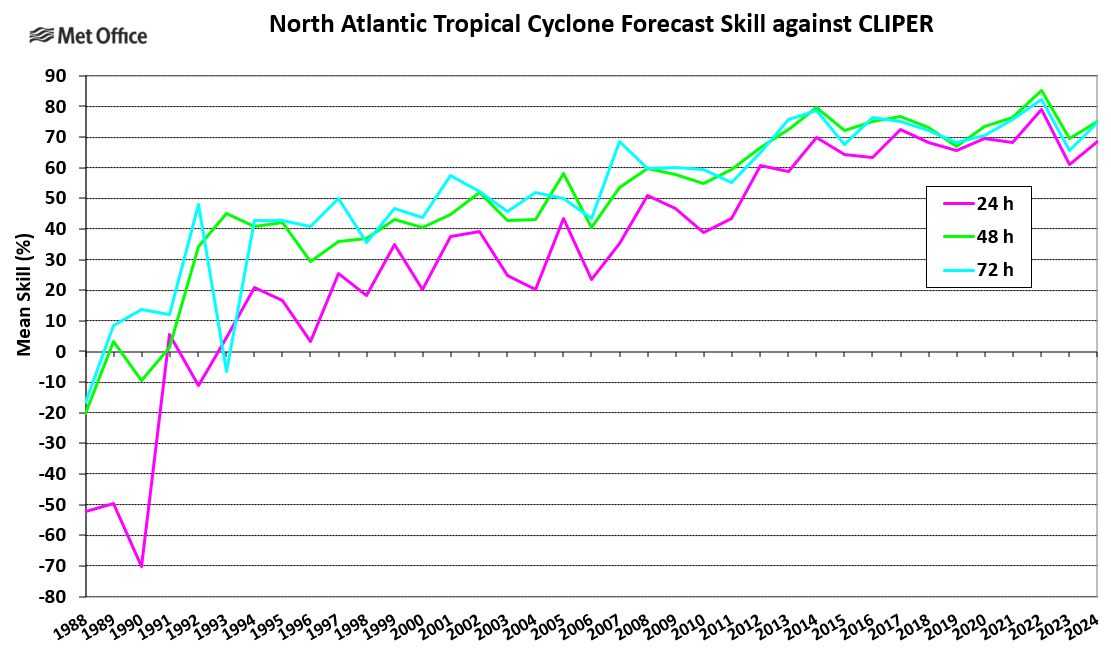
2022 was an active season with a large number of tropical storms. Track forecast errors were larger than the 5-year running mean . There was a weak bias in forecasts, but not as large as in other basins.
3.4 North Indian Basin Storms
| T+0 | T+24 | T+48 | T+72 | T+96 | T+120 | T+144 | T+168 | |
| Possibly verified | 53 | 37 | 27 | 19 | 13 | 11 | 9 | 7 |
| Detection rate (%) | 100 | 100 | 100 | 100 | 100 | 91 | 89 | 86 |
| AT error (km) | 1 | -9 | -9 | -8 | 74 | 149 | 306 | 338 |
| CT error (km) | -7 | 13 | 27 | 4 | 31 | 56 | 32 | -88 |
| Track skill (%) | ***** | 52 | 68 | 67 | ***** | ***** | ***** | ***** |
| * 2018-22 skill (%) | ***** | 51 | 54 | 61 | ***** | ***** | ***** | ***** |
| DPE (km) | 33 | 60 | 97 | 154 | 213 | 324 | 396 | 406 |
| * 2018-22 DPE (km) | 44 | 76 | 134 | 195 | 256 | 357 | 528 | 606 |
| Central pressure bias (mb) | 0.6 | 7.5 | 8.6 | 1.4 | 3.2 | 7.7 | 2.6 | 6.5 |
* 5-year running mean DPE and skill for all North Indian storms for 2018-22
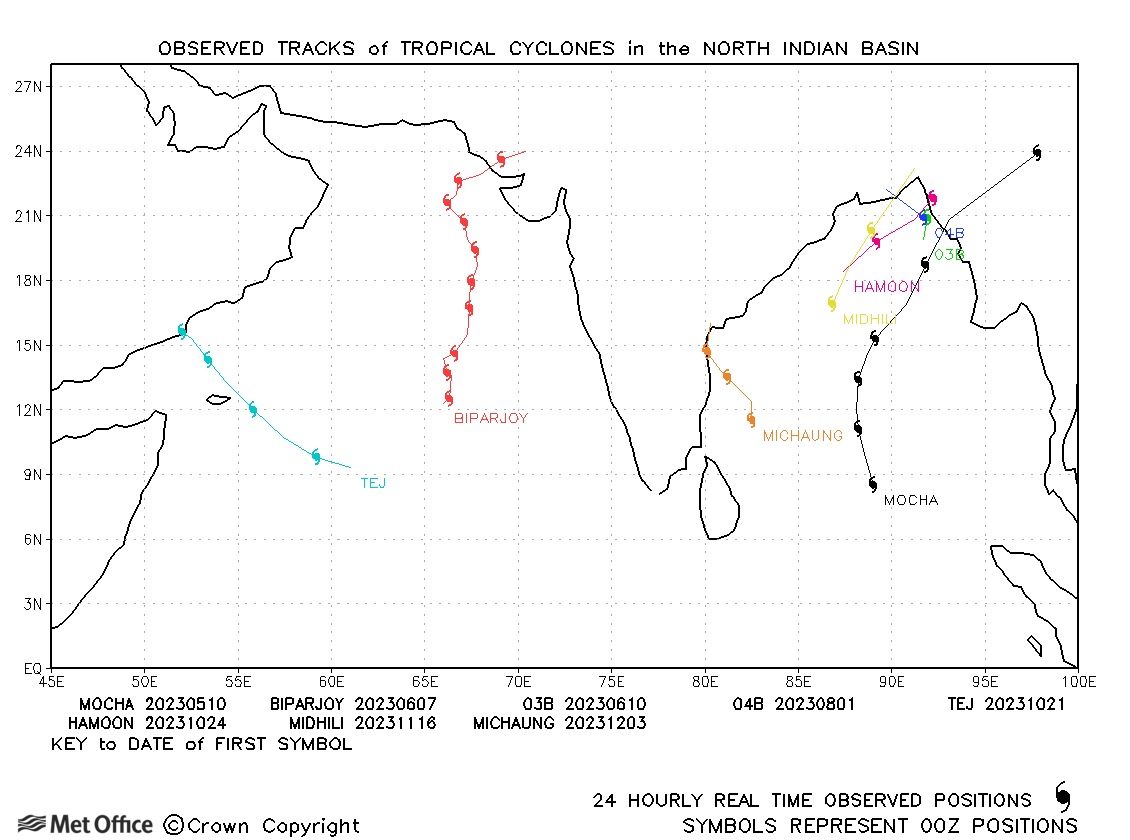
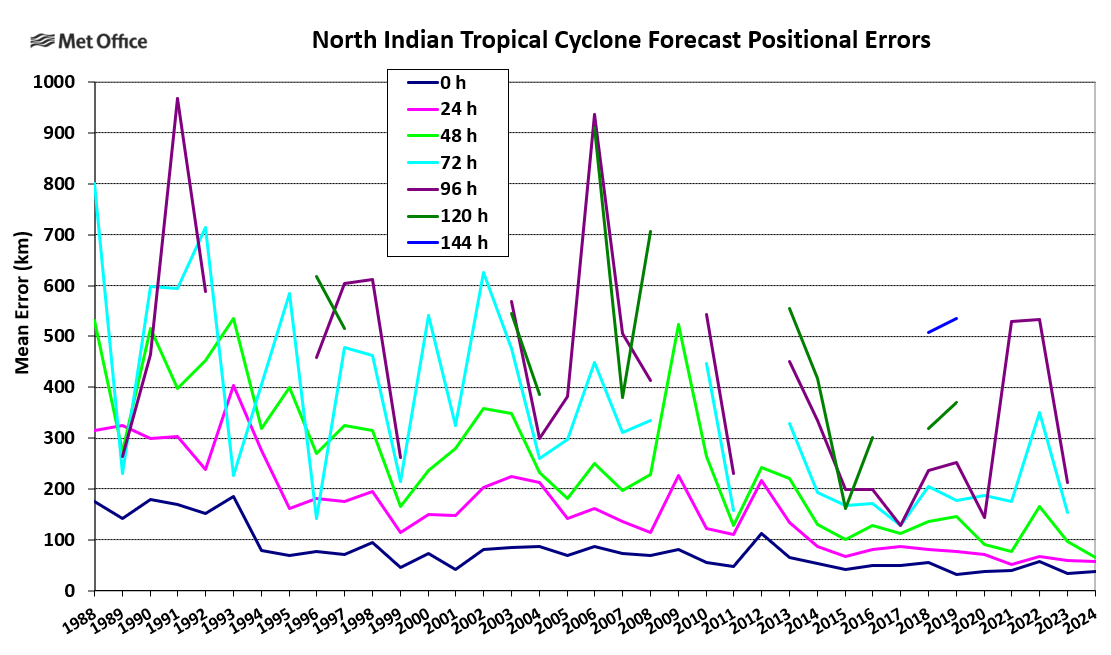
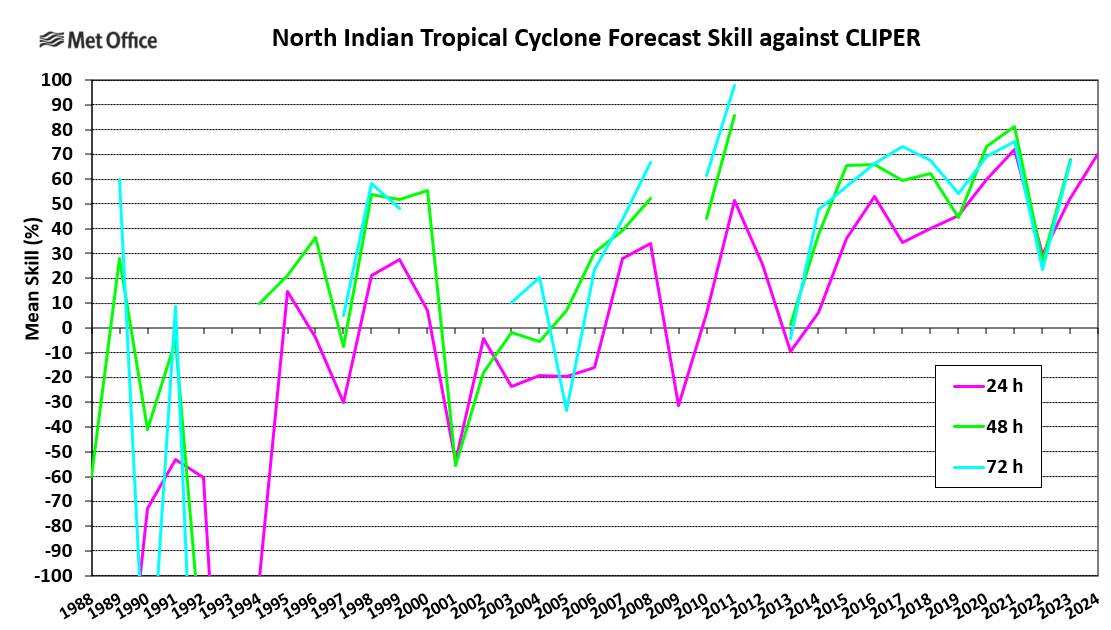
There were more strong cyclones than in 2022. Track forecast errors were low compared to the previous 5-year running mean. There was a small weak bias in forecast central pressure.
3.5 Combined statistics for whole northern hemisphere
| T+0 | T+24 | T+48 | T+72 | T+96 | T+120 | T+144 | T+168 | |
| Possibly verified | 628 | 503 | 398 | 315 | 248 | 197 | 153 | 111 |
| Detection rate (%) | 100 | 98 | 98 | 97 | 95 | 92 | 84 | 78 |
| AT error (km) | 2 | 1 | 0 | -3 | -27 | -42 | -103 | -83 |
| CT error (km) | -4 | 0 | 3 | 6 | 22 | 38 | 26 | -25 |
| Track skill (%) | ***** | 61 | 71 | 70 | ***** | ***** | ***** | ***** |
| * 2018-22 skill (%) | ***** | 63 | 69 | 70 | ***** | ***** | ***** | ***** |
| DPE (km) | 34 | 68 | 119 | 197 | 286 | 415 | 553 | 655 |
| * 2018-22 DPE (km) | 33 | 68 | 125 | 192 | 268 | 352 | 482 | 598 |
| Central pressure bias (mb) | 2.2 | 8.4 | 12.4 | 13.9 | 16.7 | 17.8 | 16.7 | 13.9 |
* 5-year running mean DPE and skill for all northern hemisphere storms for 2018-22
Whilst the number of storms was similar to 2023, they were longer lived resulting in a much highger number of verifiable forecasts than in 2022.
Track forecast errors were near to the 5-year running mean at short lead times, but higher at longer lead times. Thjere was a slight slow bias at longer lead times. Detection percentages were mostly high, but dropped off at longer lead times.
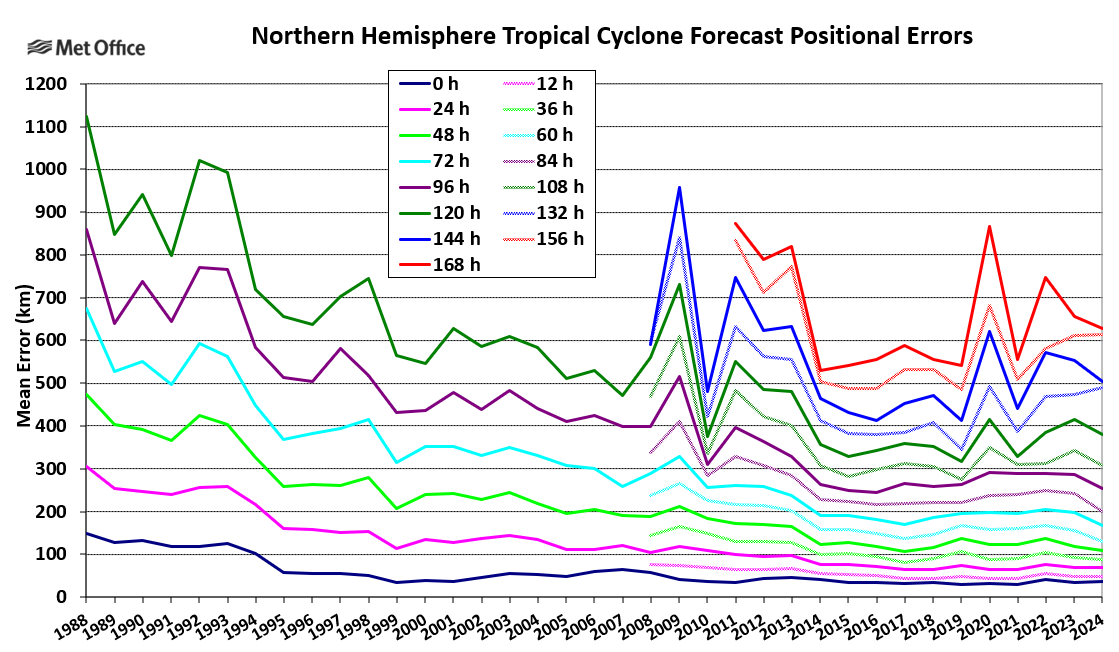
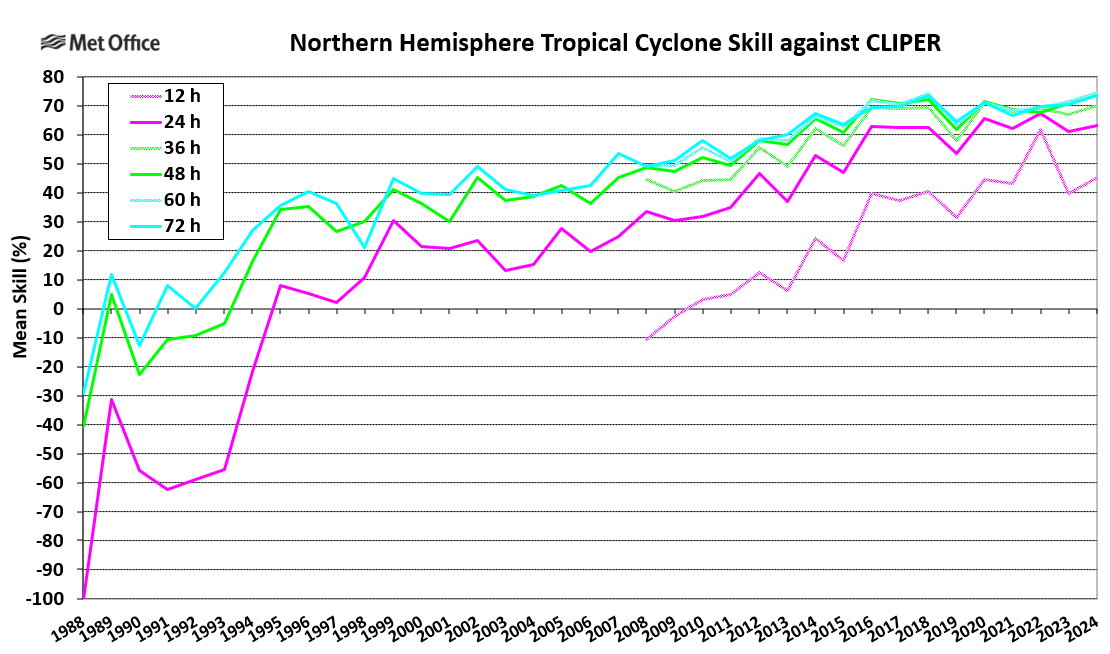
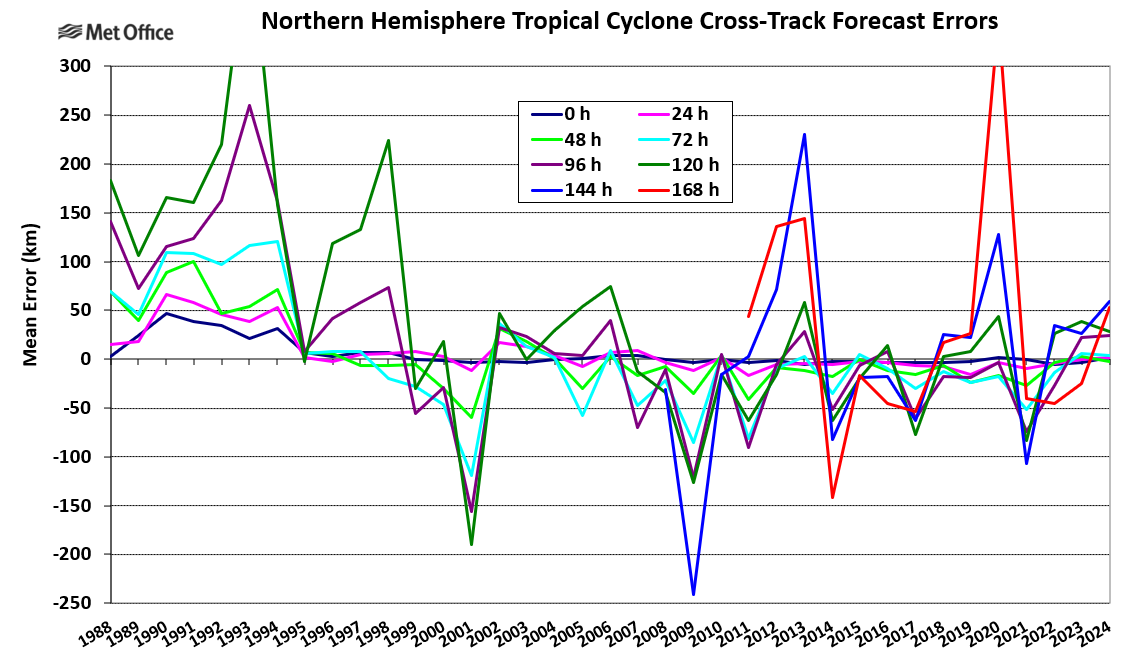
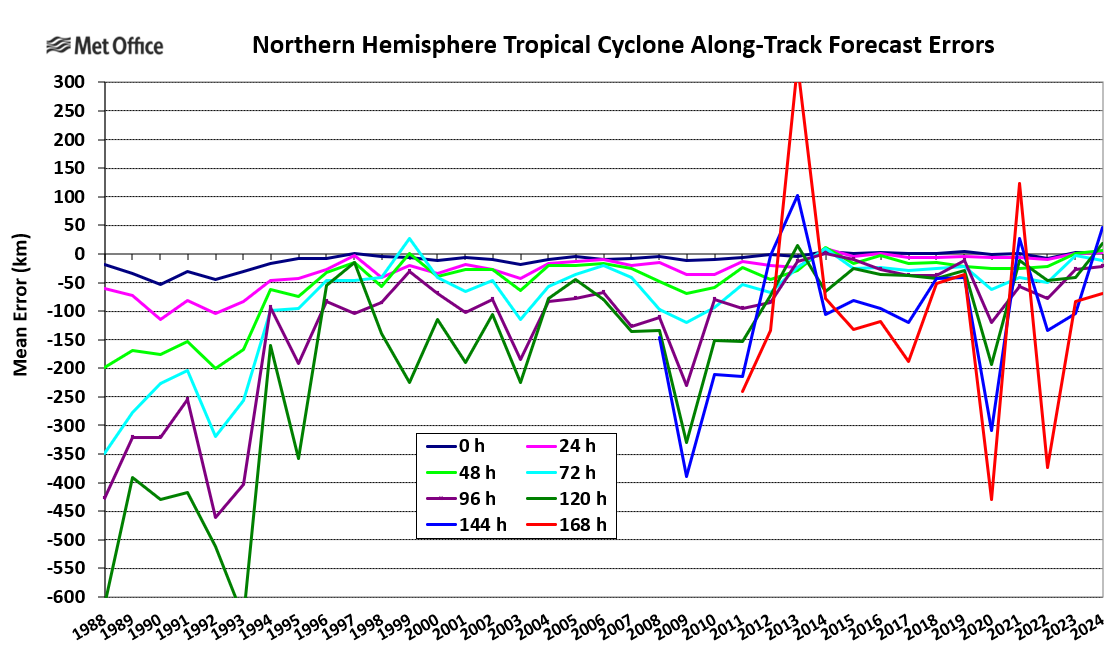
The 5-year running mean of track forecast errors continues to increase slightly at longer lead times.
The intensity bias as measured by central pressure was positive (weak bias) and growing with lead time. Similarly 10m winds had a weak bias which increased with lead time. This is similar to what was seen in 2022 following the introduction of global model configuration GC4 in May 2022. Mean absolute errors for central pressure were similar to recent years all but the longest lead times. For 10m winds the mean absolute errors were similar to 2022 and larger than all earlier years from lead times of 24 hours onwards.
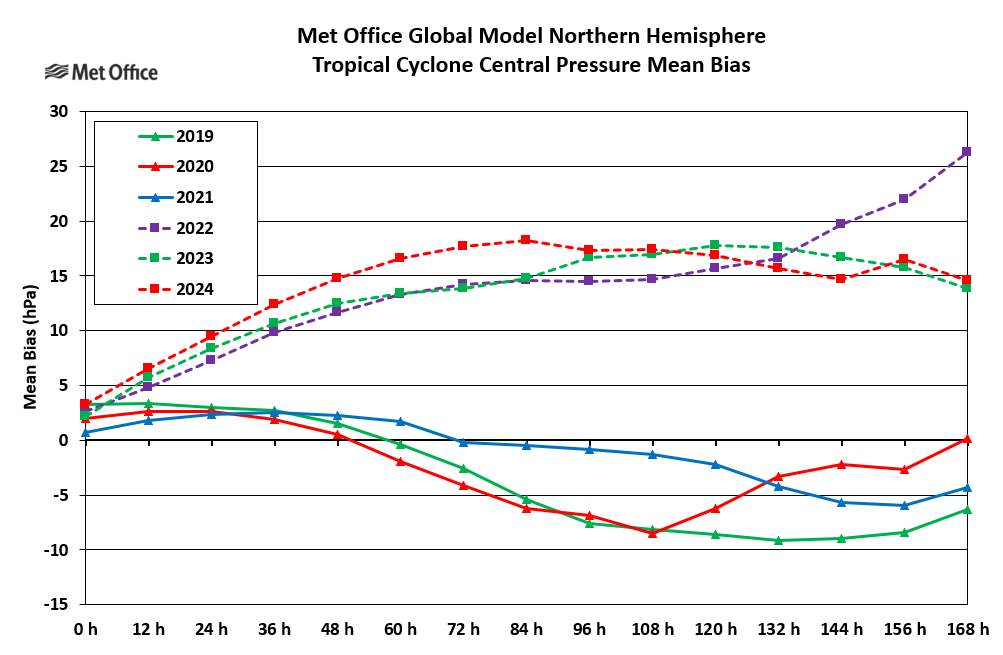
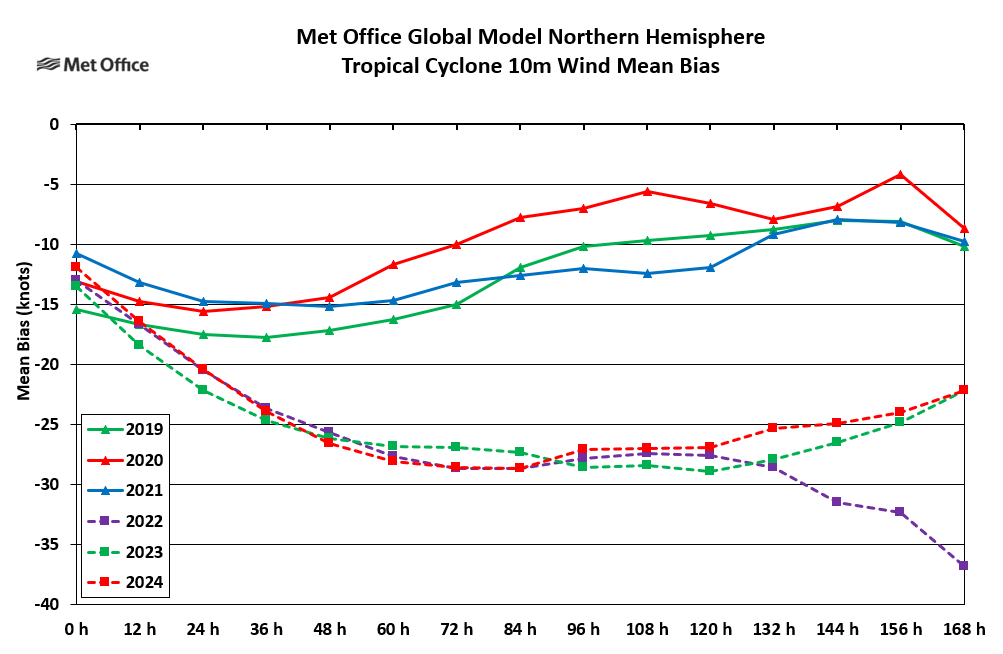
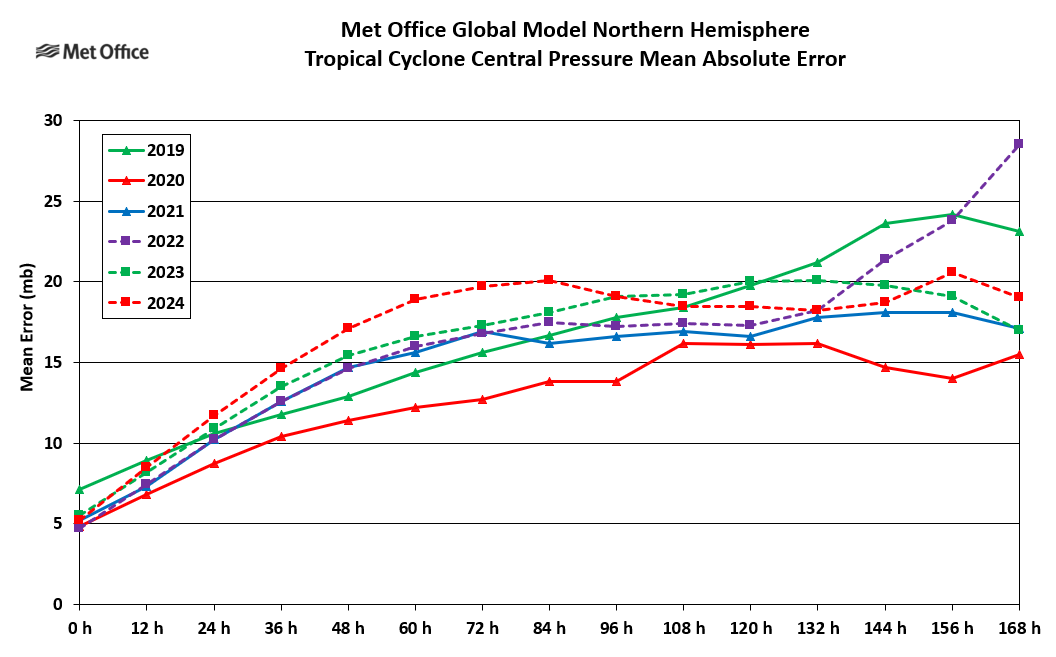
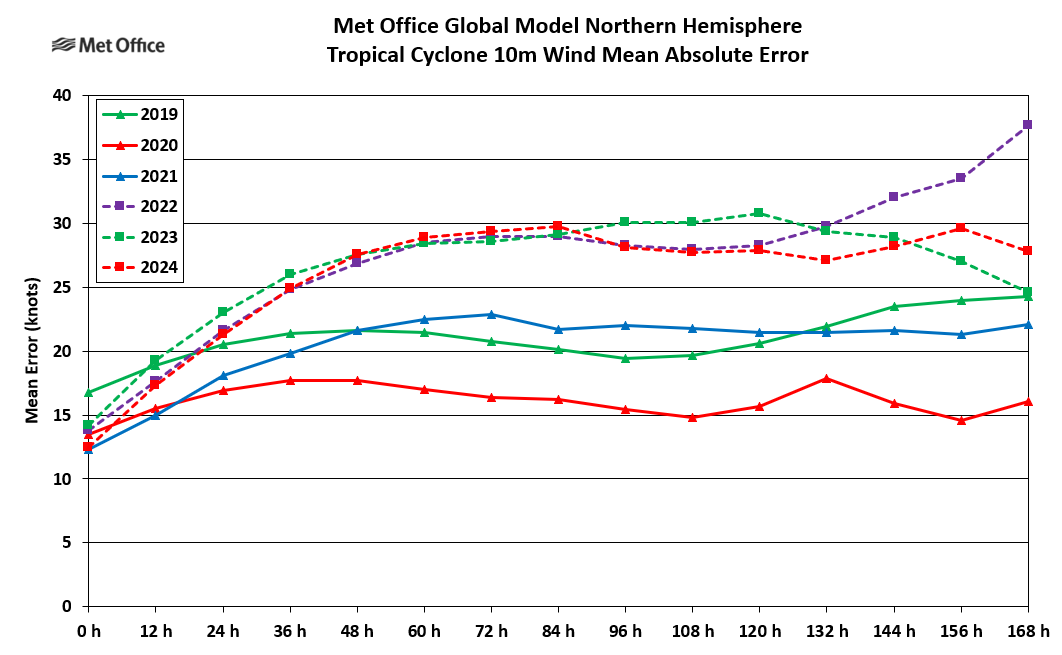
4. Further tropical cyclone information
The Met Office tropical cyclone web pages contain information on tropical cyclone forecasting at the Met Office. Summaries of tropical cyclone activity and forecasts are made at the end of each season, together with observed and forecast track information, track and intensity prediction error statistics, lists of names and real-time tropical cyclone forecast guidance.
For further information on tropical cyclone forecasting email the Met Office.



